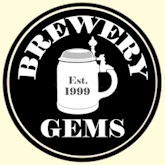In 1877, Goellert was found guilty on three of four counts of selling alcohol to the indians, which may been instrumental in his sale of the brewery the following year. Goellert then moved north to New Westminster, B.C., where he established the City Brewery.
William Roesch and his partner, P. Wagner, took possesion of the property, and changed the name to the Washington Brewery, as shown on the Dec. 26, 1878, newspaper ad (below).
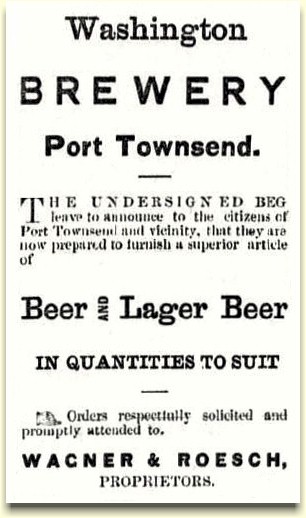
The partnership of Wagner & Roesch lasted less than six months, when on May 15, 1879, Charles Eisenbeis purchased Wagner's controlling interest in the brewery.
Eisenbeis was the owner of the Pioneer Bakery, which supplied merchant
vessels with crackers and ship's bisquits (aka hardtack). He was also
the city's first mayor, serving three terms.
Roesch remained as brewer and even boarded with Eisenbeis, until late in 1880, when he sold out and moved to Oregon. There he starting a small brewery in Heppener, and then in 1882, he established the City Brewery in Pendleton.
Eisenbeis' Washington Brewery produced draft beer in kegs, but it's
not known whether he bottled any of his beer. In 1888, Eisenbeis closed
the brewery, and the city was to wait 17 years until it again had
locally made beer.
PORT TOWNSEND BREWING CO.
The new brewery was built by local investors George Watkins, Michael Hartman, and Newton W. O'Rear. They established the company on 5 Sept. 1905, after raising $25,000 in capital stock for the venture. The brewery was to be built on site of the old Washington Brewery.
On 5 June, 1905, the local
newspaper, the Daily Leader, covered the building plans for the new
venture:
"The Old Brewery site has an old frame
building on it that will have to be torn down, but the basement is of
stone and is in good shape and in all probability be utilized to
advantage in the construction of the new plant."
"Port Townsend beer drinkers will be given an opportunity today to test the product of the new Port Townsend Company's product the brew that might make the city famous."
The
following day, on 10 June 1906, the Daily Leader had glowing words for
the new enterprise:
"Home-Made Beverage Finds Favor With the Public
-- SPARKLING, PURE AND HEALTHFUL -- In a good cause, if such is ever
permissible, citizens of Port Townsend drank beer yesterday. It was good
beer, too. The extenuating feature of the occasion was the right to properly
dedicate to public favor a home product - Port Townsend beer. ...The
beverage sold yesterday over every bar in the city is of a character meeting
the ideas of the epicure on liquid sociability. There is purity, depth and
body to drink that should bring success to the makers in their efforts to
claim the patronage of the public throughout this section."
The article went on to report that while only draught beer is available, it's the company's intention to install bottling equipment in the near future. The principals, Michael Hartman and George Watkins, took an active role in the company, with Hartman as president, and Watkins serving as secretary/manager.
New Owners
"OLYMPIAN BUYS PORT TOWNSEND BREWERY -Jacob Duttenhoefer, for several years chief engineer of the Olympia Brewing company, has purchased controlling interest in the Port Townsend Brewing company at Port Townsend, from George Watkins and will at once assume the management of the company. He severed his connections with the local company and left here about a week ago to close the deal. Mr. Duttenhoefer plans an immediate improvement of the plant, including an enlarged ice making plant and increased facilities permitting an increased output."
As far as the public
was concerned, the new owner was Jacob "Jake" Dutterhoefer. But just as
in the 1903 purchase of the Salem Brewery
Assn., where the deal was made by a front
man for Leopold Schmidt (see
biography),
this too was a case where he preferred to keep his financial interests
private. This acquisition fit nicely with Schmidt's multiple brewery
concept, and was not intended to carry the
Olympia Brewing name.
Jacob Duttenhoefer, and Ernest Studerus, replaced Hartman and Watkins,
with Duttenhoefer assuming the position of president/manager, and
Studerus as secretary and brewmaster. However Hartmann retained an
interest in the venture. Also, H. H. Morrison held the position of
vice-pres./treas. for a short time, as he was also a stockholder.
As Schmidt's chief engineer, Jake Duttenhoefer had
also been his trouble shooter. When Schmidt was planning a brewery in
Redding, Calif., Jake was the point man, and when they instead chose to go
with an agent and bottling works, Jake was again sent to trouble shoot
problems with the equipment and management.
An added product line for the Brewery was announced on 25 January 1910, with the installation of a soda water works. The new equipment will enable them to produce "...all kinds of carbonated water, syrups, cordials, etc."
On 3 February 1910, the Daily Leader announced the Brewery's plans for the construction of a 100' X 30' ice plant. It was to have a concrete foundation, with a two story building of brick. The capacity of the plant would be 30 to 40 tons per day, which would allow the capacity of the brewery to increase to double its current output. With its product then supplying only the Olympic Peninsula, this expansion would allow the company to make their beer available to the whole Puget Sound area, and into Alaska. The newspaper article said:
"The company will also commence putting up a building for its bottling works on a lot across Monroe Street, opposite the brewery, and when this building is completed a specialty will be made of its bottled product."
The following August, plant manager, Duttenhoefer had a dynamo installed for their new electric light plant. This was to provide for brewery lighting and the running of lighter electric machinery.
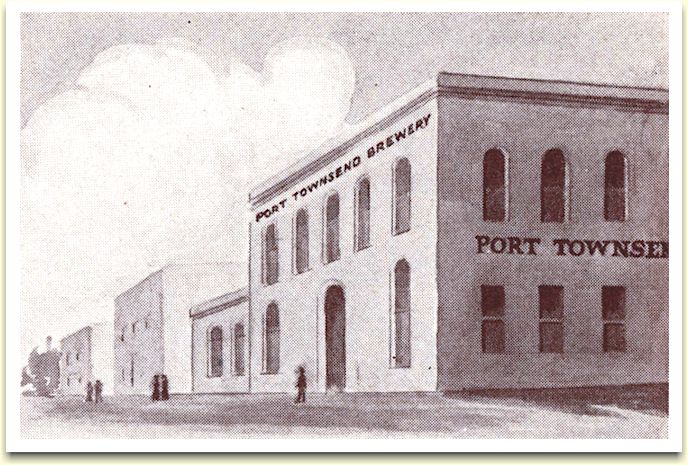
Port Townsend Brewery's brick Ice House
This new Olympia branch never
produced Schmidt's flagship brand, "Olympia Pale Export" but continued to
brew the popular "Townsend Beer" and "Key City Beer." In fact none of the
other of Schmidt's plants (Bellingham, Salem, or San Francisco) had good
enough water to produce "Olympia Beer."
Perhaps it was the quality of the water, but the plant was having problems
with the quality of their beer. On January 4, 1911, Duttenhoefer wrote to
Leopold Schmidt:
"We have been having a hazy beer for some
time. Well, in fact, ever since I've been here and it seems that we
cannot overcome it. I intended several times to increase the price
of our beer but cannot do it on account of the haziness, as I have
nothing to stand on to make the talk as to better quality and the
increased cost of brewing materials. I am seriously thinking of
changing brew masters. I think I could get the brew master from the
Port Angeles Brewery, and I believe he is a good man from what I
have seen that he has to work on and the quality of beer he
produces. Of course Mr. Studerus is a stockholder in this company to
the extent of $1000.00 and seems to do the best he can, but he
cannot produce the goods." Duttenhoefer was successful
in replacing Sturdeus with a new brew master, but not from Port Angeles.
Instead, he acquired the services of Gustaf Beier. They apparently corrected
their haziness problem and continued selling their draft and bottled beer.
The above letter would lead one to believe that Duttenhofer would steal a
competitor's brew master, but the
Angeles Brewing & Malting Co. was having
financial difficulties and had been in bankruptcy proceedings since April of
1910. On 18 Jan. 1911, stockholders meet and elected
officers of the firm. Jacob Duttenhofer remained as president and general
manager; Michael Hartman became v-p and replaced Studerus as secretary; and
H. H. Morrison became treasurer. In early 1914, the
Port Townsend brewery again revised their label - this time to the the one
shown below. But it was short lived as state-wide Prohibition was chosen by
the voters in November 1914, giving the brewers until January 1916 to sell
their stock, and to discontinue the manufacture of beer.
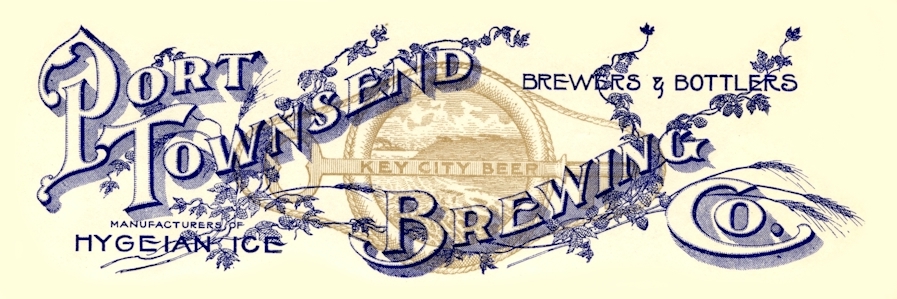
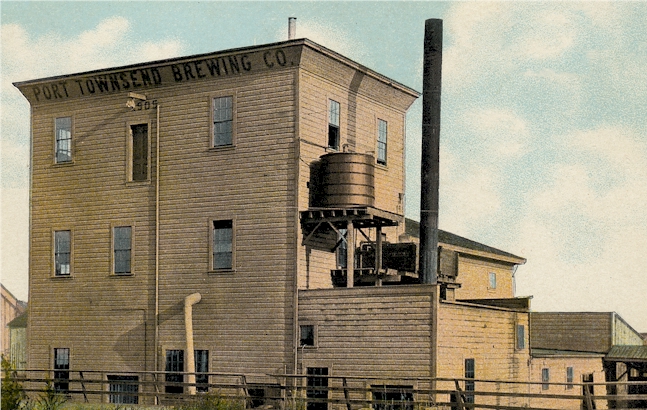
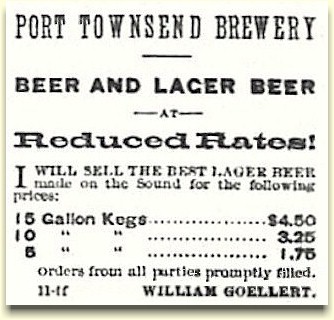
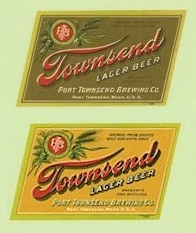 This
label comes in a metallic green, and a non-metallic yellow (left), and a
light metallic gold
This
label comes in a metallic green, and a non-metallic yellow (left), and a
light metallic gold
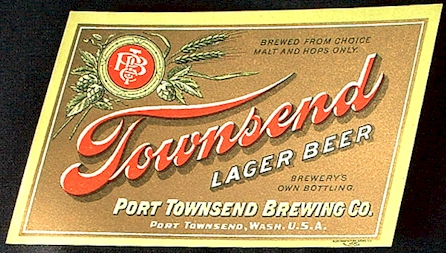
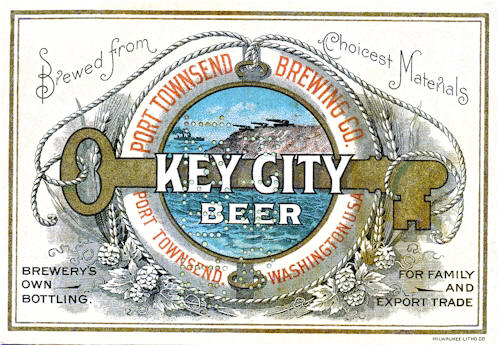
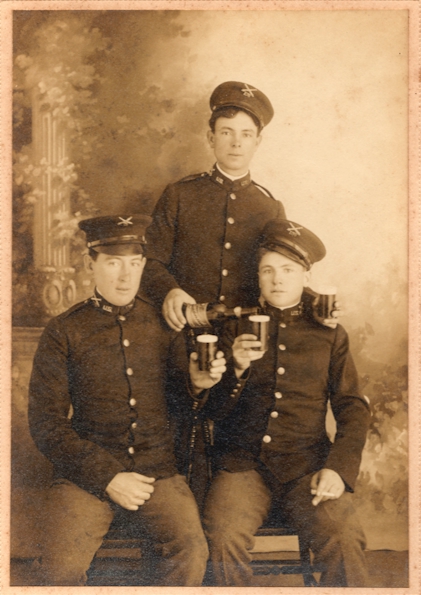
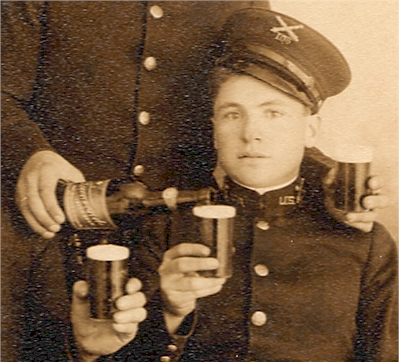
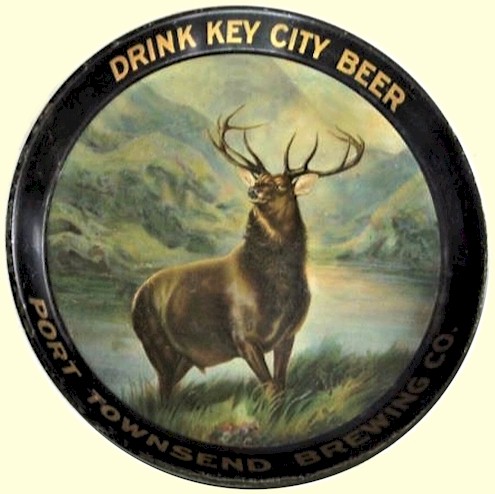
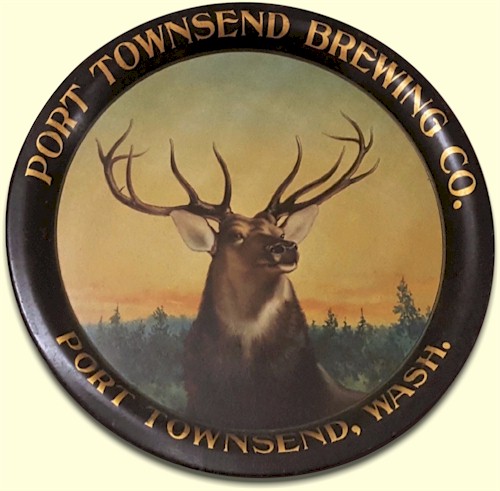
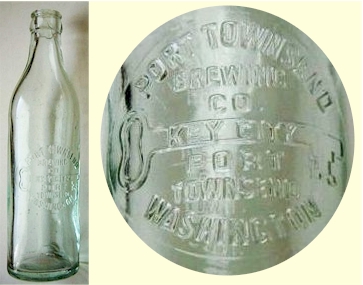
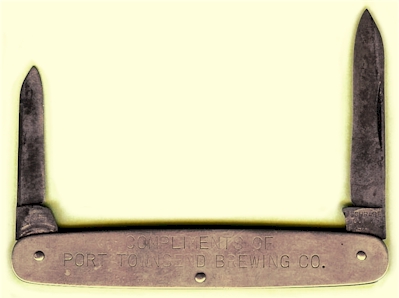
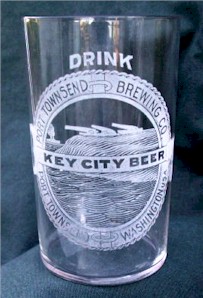
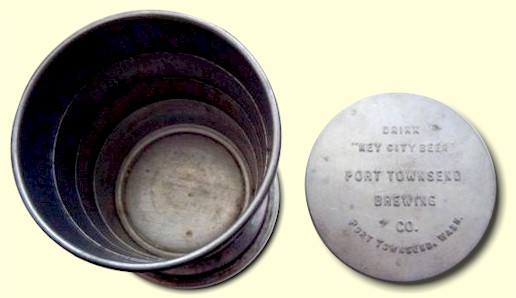
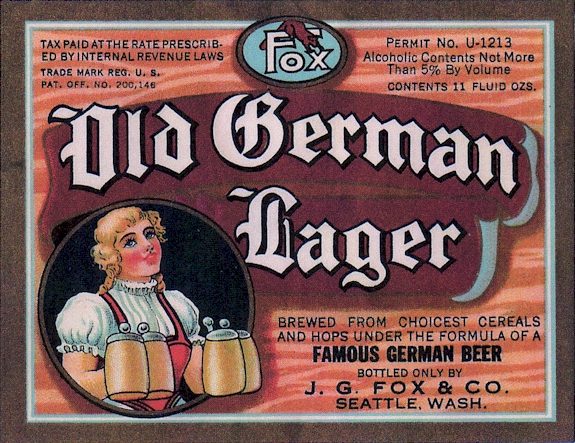
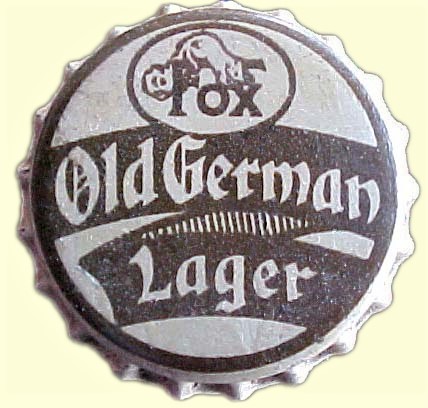 The label bears a permit number that identifies Peninsula Brewery as the
manufacturer of this beer. These numbers were issued to brewers by the U.S.
Government following prohibition as a method of licensing. The numbers were
required to be on all product labels from 1933 until September of 1935.
The label bears a permit number that identifies Peninsula Brewery as the
manufacturer of this beer. These numbers were issued to brewers by the U.S.
Government following prohibition as a method of licensing. The numbers were
required to be on all product labels from 1933 until September of 1935.
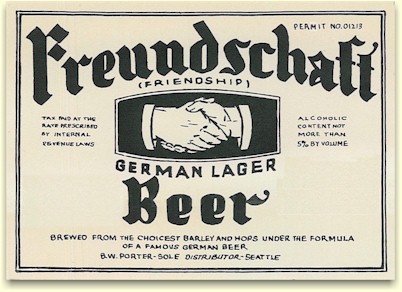
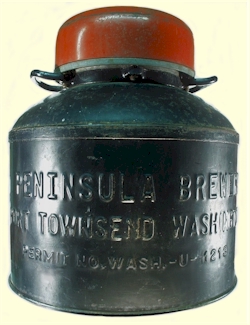 The
device shown here was found in 1986 by the new owners of Aldrich's
Grocery Store in Port Townsend. Ben Aldrich was a Peninsula Brewery
stock-holder and no doubt offered beer off-sale from his premises.
The
device shown here was found in 1986 by the new owners of Aldrich's
Grocery Store in Port Townsend. Ben Aldrich was a Peninsula Brewery
stock-holder and no doubt offered beer off-sale from his premises.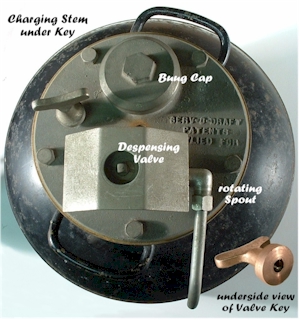
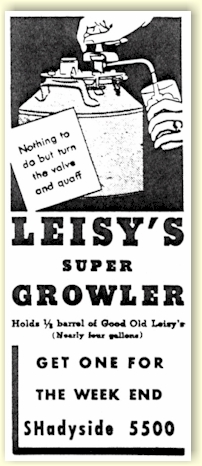
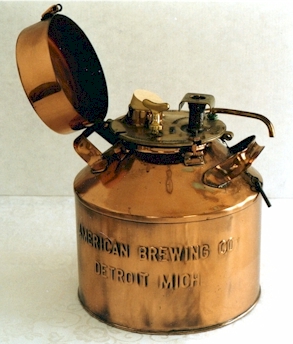 Serv-O-Draft had a Detroit
competitor for these dispensers called "Acme Containers" which were
produced by Miller-Shelby Products of Detroit.
The body looked like a stubby milk can (handles on the shoulder), and
the top plate and fittings appear to be bronze. Also there was no
threaded filling cap, but rather a flared opening which would have
required a wooden bung. One example of the Miller-Shelby units, made for
the American Brewing Co. of Detroit, shown here is impressive with its
copper plated body. They dubbed their dispensers a
Serv-O-Draft had a Detroit
competitor for these dispensers called "Acme Containers" which were
produced by Miller-Shelby Products of Detroit.
The body looked like a stubby milk can (handles on the shoulder), and
the top plate and fittings appear to be bronze. Also there was no
threaded filling cap, but rather a flared opening which would have
required a wooden bung. One example of the Miller-Shelby units, made for
the American Brewing Co. of Detroit, shown here is impressive with its
copper plated body. They dubbed their dispensers a
